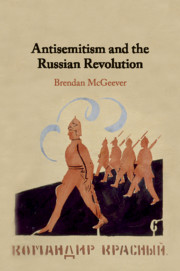Book contents
- Antisemitism and the Russian Revolution
- Antisemitism and the Russian Revolution
- Copyright page
- Contents
- Figures
- Acknowledgements
- A Note on Translation
- Terms and Abbreviations
- Introduction
- 1 1917: Antisemitism in the Moment of Revolution
- 2 ‘Red Pogroms’: Spring 1918
- 3 The Soviet Response to Antisemitism, 1918
- 4 Antisemitism and Revolutionary Politics: the Red Army in Ukraine, 1919
- 5 The Soviet Response to Antisemitism in Ukraine, February–May 1919
- 6 Jewish Communists and the Soviet Response to Antisemitism, May–December 1919
- 7 Reinscribing Antisemitism?
- Epilogue: In the Shadow of Pogroms
- Conclusions: Anti-Racist Praxis in the Russian Revolution
- Bibliography
- Index
4 - Antisemitism and Revolutionary Politics: the Red Army in Ukraine, 1919
Published online by Cambridge University Press: 16 September 2019
- Antisemitism and the Russian Revolution
- Antisemitism and the Russian Revolution
- Copyright page
- Contents
- Figures
- Acknowledgements
- A Note on Translation
- Terms and Abbreviations
- Introduction
- 1 1917: Antisemitism in the Moment of Revolution
- 2 ‘Red Pogroms’: Spring 1918
- 3 The Soviet Response to Antisemitism, 1918
- 4 Antisemitism and Revolutionary Politics: the Red Army in Ukraine, 1919
- 5 The Soviet Response to Antisemitism in Ukraine, February–May 1919
- 6 Jewish Communists and the Soviet Response to Antisemitism, May–December 1919
- 7 Reinscribing Antisemitism?
- Epilogue: In the Shadow of Pogroms
- Conclusions: Anti-Racist Praxis in the Russian Revolution
- Bibliography
- Index
Summary
The arc of antisemitic violence in the Russian Revolution peaked in Ukraine in 1919. Following the Bolshevik retreat in April 1918, a new Hetman government backed by the Central Powers was formed, with Pavlo Skoropadsky as head of state. The Hetman regime, however, was ousted in December 1918 by the Ukrainian uprising led by Simon Petliura and Volodymyr Vynnychenko, who formed the Directory government within a newly constituted Ukrainian People’s Republic.1 The Directory’s existence would also be short lived: no sooner had it been established, the Bolsheviks commenced what became known as their ‘second campaign’ to retake control of Ukraine, which they did with relative ease.2 On 3 January 1919, the Red Army secured Kharkiv, and by 4 February, just as in 1918, the Party was once again in control of Kyiv.3 During the ensuing war between the Ukrainian Army and the Soviet Red Army in January and February 1919, a number of pogroms were carried out by Petliura’s forces, most notably in Zhytomyr and Berdychiv in January, and, worst of all, Proskuriv (present-day Khmel’nytskyi) in February.4 In the latter case, more than 1,650 Jews were murdered in just four hours by the Ukrainian Army following an unsuccessful attempt by the Bolsheviks to capture the town.5
- Type
- Chapter
- Information
- Antisemitism and the Russian Revolution , pp. 88 - 111Publisher: Cambridge University PressPrint publication year: 2019



